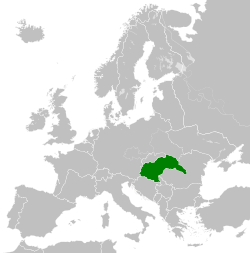Kingdom of Hungary (1920–1946)
Central European state between 1920 and 1946
The Kingdom of Hungary (Hungarian: Magyar Királyság), sometimes known as the Regency or the Horthy era, existed as a country from 1920 to 1946 under the rule of Regent Miklós Horthy.
Kingdom of Hungary Magyar Királyság (Hungarian) | |
|---|---|
| 1920–1946 | |
| Motto: Regnum Mariae Patrona Hungariae (Latin) ("Kingdom of Mary, the Patron of Hungary") | |
| Anthem: Himnusz (English: "Hymn") | |
 The Kingdom of Hungary in 1942 | |
| Capital and largest city | Budapest |
| Official languages | Hungarian |
| Recognized regional languages | Rusyn[1][2] (in Subcarpathia) |
| Spoken | Romanian • German • Slovak • Croatian • Serbian • Yiddish • Slovenian • Romani[3] |
| Ethnic groups (1941)[3] | |
| Religion (1941)[3] | List
|
| Demonym(s) | Hungarian |
| Government | Authoritarian regency (1920–1944) Hungarist totalitarian one-party dictatorship (1944–1945) Transitional coalition government (1945–1946) |
| King | |
• 1920–1946 | Vacant [note 1] |
| Head of state | |
• 1920–1944 | Miklós Horthy[note 2] |
• 1944–1945 | Ferenc Szálasi[note 3] |
• 1945–1946 | High National Council[note 4] |
| Prime minister | |
• 1920 (first) | Károly Huszár |
• 1945–1946 (last) | Zoltán Tildy |
| Legislature | Diet |
• Upper | Felsőház |
• Representatives | Képviselőház |
| Historical era | Interwar · World War II |
| 29 February 1920 | |
| 4 June 1920 | |
| 2 November 1938 | |
| 30 August 1940 | |
| 16 October 1944 | |
| 1 February 1946 | |
| Area | |
| 1920[4] | 92,833 km2 (35,843 sq mi) |
| 1930[5] | 93,073 km2 (35,936 sq mi) |
| 1941[6] | 172,149 km2 (66,467 sq mi) |
| Population | |
• 1920[4] | 7,980,143 |
• 1930[5] | 8,688,319 |
• 1941[6] | 14,669,100 |
| Currency | Hungarian korona (1920–1927) Hungarian pengő (1927–1946) |
| Time zone | UTC+1 (CET) |
• Summer (DST) | UTC+2 (CEST) |
| [note 5] | |
| Driving side | right (from 1941) |
References
change- ↑ "A m. kir. minisztérium 1939. évi 6.200. M. E. számú rendelete, a Magyar Szent Koronához visszatért kárpátaljai terület közigazgatásának ideiglenes rendezéséről" [Order No. 6.200/1939. M. E. of the Royal Hungarian Ministry on the provisional administration of the Subcarpathian territory returned to the Hungarian Holy Crown]. Magyarországi Rendeletek Tára (in Hungarian). 73. Budapest: Royal Hungarian Ministry of the Interior: 855. 1939.
- ↑ Fedinec, Csilla (2002). "A Kárpátaljai Kormányzóság idõszaka" [The period of the Governorate of Subcarpathia]. A kárpátaljai magyarság történeti kronológiája, 1918-1944 [Historical chronology of the Hungarians in Subcarpathia, 1918-1944] (PDF) (in Hungarian). Galánta - Dunaszerdahely: Fórum Intézet - Lilium Aurum Könyvkiadó. p. 336. ISBN 80-8062-117-9.
- ↑ 3.0 3.1 3.2 Fogarasi, Zoltán (1944). "A népesség anyanyelvi, nemzetiségi és vallási megoszlása törvényhatóságonkint 1941-ben" [Distribution of the population by mother tongue, ethnicity and religion in the municipalities of Hungary in 1941.]. Magyar Statisztikai Szemle (in Hungarian). 22 (1–3). Budapest: Royal Hungarian Central Statistical Office: 4, 13.
- ↑ Kollega Tarsoly, István, ed. (1995). "Magyarország". Révai nagy lexikona (in Hungarian). Vol. 20. Budapest: Hasonmás Kiadó. pp. 595–597. ISBN 963-8318-70-8.
- ↑ Kollega Tarsoly, István, ed. (1996). "Magyarország". Révai nagy lexikona (in Hungarian). Vol. 21. Budapest: Hasonmás Kiadó. p. 572. ISBN 963-9015-02-4.
- ↑ Élesztős László; et al., eds. (2004). "Magyarország". Révai új lexikona (in Hungarian). Vol. 13. Budapest: Hasonmás Kiadó. pp. 882, 895. ISBN 963-9556-13-0.

